![]()
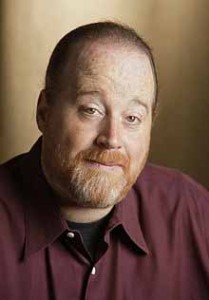
“Usually an actor has some information about what’s going through their character’s head, based upon the dialog. In this performance, Glass crawls out of his grave, crawls across the ground, and there’s no other information in the script,” shared Mirrione. “Leo brought this real depth of inner motivation. I was always engaged with what he was thinking and what he was going through.”
With such an atmospheric film, creating a full world for the character is essential in telling the story. For one scene, Mirrione was cutting, layering wind, birds and all the background, but it was not playing as emotionally as when he first watched it. Trying to determine why he had lost that initial feeling, Mirrione went back to watching the raw footage and realized, “His performance was perfectly in sync with the natural sound of the space. There was this really far off crow that he was reacting to. His complete commitment to the moment was so perfect.”
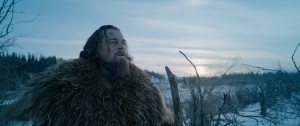
“Without his amazing ability to communicate through his eyes and through his breathing, we wouldn’t have had those kinds of opportunities,” said Mirrione.
In addition to the extremely good actors in the film, there were also a lot of good non-actors, hired through casting calls. “Alejandro is so brilliant at getting to the core of what makes somebody a really special life force,” Mirrione explained. “A lot of the non-actors in the movie did such remarkable jobs being so expressive and emotional.”
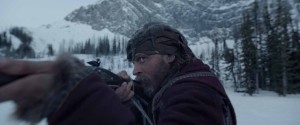 The editor was particularly impressed with Arthur RedCloud, who played the Pawnee that befriended Glass, and thought it was amazing to hear his personal story. When RedCloud was growing up, he was told that he would be a medicine man. He became a truck driver, but when he answered the casting call, he got the part of a medicine man and in a way fulfilled his destiny.
The editor was particularly impressed with Arthur RedCloud, who played the Pawnee that befriended Glass, and thought it was amazing to hear his personal story. When RedCloud was growing up, he was told that he would be a medicine man. He became a truck driver, but when he answered the casting call, he got the part of a medicine man and in a way fulfilled his destiny.
“To me, there was something that was so beautiful about that and how it reverberated with the themes of the movie,” shared Mirrione. “That is one example of the passion people brought. It was not just him. It was everybody. They were able to bring their own personal experiences to the movie, which I think is what made it so much more special.”
According to the editor, the script was really an outline. Once they reached the point of shooting the film, the team had to do a lot of restructuring. The way the scenes came to life relied heavily on the perspective that the actors brought to the performances. As they continued working, the filmmakers realized certain elements were not coming across the way they imagined.
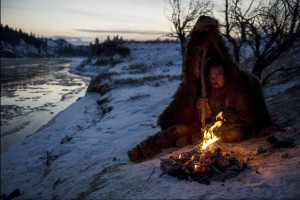 The filmmakers also realized the importance that the violently realistic bear mauling played in the story. They needed to make sure the attack happened as soon as possible. “That meant figuring out ways to move things around to make sure that was happening at exactly the right moment,” Mirrione revealed.
The filmmakers also realized the importance that the violently realistic bear mauling played in the story. They needed to make sure the attack happened as soon as possible. “That meant figuring out ways to move things around to make sure that was happening at exactly the right moment,” Mirrione revealed.
The entire hour or so of the movie after the character of Glass is left on his own, went through many iterations trying to find the exact right sequence of events to make sure the story arc worked perfectly. Some things don’t translate the same way from the page to the screen. Mirrione explained, “Like Glass looking off into a vista, doesn’t mean the same reading it in a script, compared to seeing the poetry of that onscreen.”
Fitzgerald’s (Tom Hardy) squirrel speech came at the right spot in the script, but in the context of the movie, it came a bit too late. “By putting it early, it helped inform all the scenes that came after it,” stated Mirrione. “It took a long time moving that around to find the exact right spot.”
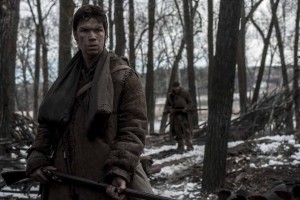 Production began shooting in September 2014, but they were “at the top of the world,” often with only 6-7 hours of daylight to film. The shoot had to shut down in April 2015 because the weather warmed up, so the first and last scenes of the movie were not shot until August. The company was still able to capture around 200 hours of material.
Production began shooting in September 2014, but they were “at the top of the world,” often with only 6-7 hours of daylight to film. The shoot had to shut down in April 2015 because the weather warmed up, so the first and last scenes of the movie were not shot until August. The company was still able to capture around 200 hours of material.
The delayed shoot was “both a benefit and a curse.” Editorial had a lot of time to put the completed footage together, but the production lost the ability to properly screen the movie for feedback, since there was no beginning or end. The filmmakers had to take the feedback that they got and run it through a filter, while trying to understand the comments and make decisions.
On the plus side, having a finessed cut of the film did inform how that last scene was eventually shot. “It would have been fine except that all those sequences had massive amounts of visual effects and we were really up against a tight deadline,” noted Mirrione, who tended to work late so he would be sure to make the release date. He finished the cut in November 2015, a little over a year from the start of production. Mirrione added, “You always end up wishing you had a little more time.”
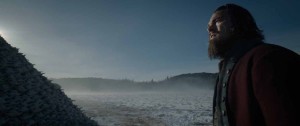 In editing visual effects-laden scenes, editorial goes through various stages, first roughing out the scene using pre-vis and other place markers prior to receiving various versions of the VFX shots. Mirrione gave the river rapids scene as a good example of an effects-heavy sequence. There were a lot of different stages, starting with cutting it together to plan how to shoot it. Once it was actually shot, they cut the sequence together so they could plan the shots that included DiCaprio.
In editing visual effects-laden scenes, editorial goes through various stages, first roughing out the scene using pre-vis and other place markers prior to receiving various versions of the VFX shots. Mirrione gave the river rapids scene as a good example of an effects-heavy sequence. There were a lot of different stages, starting with cutting it together to plan how to shoot it. Once it was actually shot, they cut the sequence together so they could plan the shots that included DiCaprio.
The difficulty of working this way was getting the sequence to have the desired power despite the temporary pieces. “You really don’t know. You’re just trusting it will work until it’s completely done,” said Mirrione.
Iñárritu, with help from cinematographer Emmanuel Lubezki, tends towards a moving camera style and long takes. Mirrione worked with the pair on a number of films, including last year’s Oscar-winning best picture, Birdman, which appears to be one long take. Through their continued collaboration, the team developed a lot of tricks and perfected how to work with the footage.
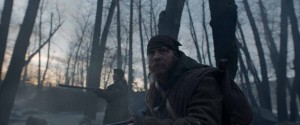 Generally the longer takes of The Revenant dictated the rhythm of the film to some extent, but the editor had to be careful because, “If that’s all that it is through the whole movie, it becomes really monotonous. You end up with the camera dictating a rhythm that can’t sustain. It took a long time to really find the rhythm of the movie without betraying the things that were working so well with the long takes.”
Generally the longer takes of The Revenant dictated the rhythm of the film to some extent, but the editor had to be careful because, “If that’s all that it is through the whole movie, it becomes really monotonous. You end up with the camera dictating a rhythm that can’t sustain. It took a long time to really find the rhythm of the movie without betraying the things that were working so well with the long takes.”
Working together, it is often said that a “short-hand” develops between a director and editor. Mirrione admits that he knows how to interpret Iñárritu’s requests and “fill in the blanks” as to what the director is asking for. There is a trust between them.
Mirrione concluded, “I know that no matter what, we’ll find a way to make it great.”





